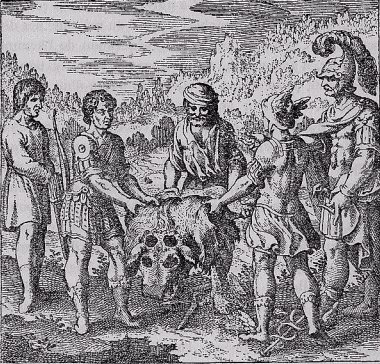|
Filius Philosophorum
The (Latin for "the philosophers' child", i.e. made by the true students of philosophy) is a symbol in alchemy. In some texts it is equated with the philosopher's stone (), but in others it assumes its own symbolic meanings. Other terms for the include ("child of wisdom"), ("our child"), ("sun child"), ("moon child"), and ("sun moon child"). There are several images that have been used to represent the . Among these are the transformed hermaphroditic Hermes Trismegistus, Hermes, the child of the Red King and the White Queen (the Sun and Moon), the child of the egg, and the three-fathered Orion (mythology), Orion. The was also one of the Jungian archetypes analyzed by the Swiss psychologist. References * * {{occult-stub Alchemical symbols ... [...More Info...] [...Related Items...] OR: [Wikipedia] [Google] [Baidu] |
Latin
Latin (, or , ) is a classical language belonging to the Italic branch of the Indo-European languages. Latin was originally a dialect spoken in the lower Tiber area (then known as Latium) around present-day Rome, but through the power of the Roman Republic it became the dominant language in the Italian region and subsequently throughout the Roman Empire. Even after the fall of Western Rome, Latin remained the common language of international communication, science, scholarship and academia in Europe until well into the 18th century, when other regional vernaculars (including its own descendants, the Romance languages) supplanted it in common academic and political usage, and it eventually became a dead language in the modern linguistic definition. Latin is a highly inflected language, with three distinct genders (masculine, feminine, and neuter), six or seven noun cases (nominative, accusative, genitive, dative, ablative, and vocative), five declensions, four ... [...More Info...] [...Related Items...] OR: [Wikipedia] [Google] [Baidu] |
Alchemy
Alchemy (from Arabic: ''al-kīmiyā''; from Ancient Greek: χυμεία, ''khumeía'') is an ancient branch of natural philosophy, a philosophical and protoscientific tradition that was historically practiced in China, India, the Muslim world, and Europe. In its Western form, alchemy is first attested in a number of pseudepigraphical texts written in Greco-Roman Egypt during the first few centuries AD.Principe, Lawrence M. The secrets of alchemy'. University of Chicago Press, 2012, pp. 9–14. Alchemists attempted to purify, mature, and perfect certain materials. Common aims were chrysopoeia, the transmutation of " base metals" (e.g., lead) into " noble metals" (particularly gold); the creation of an elixir of immortality; and the creation of panaceas able to cure any disease. The perfection of the human body and soul was thought to result from the alchemical ''magnum opus'' ("Great Work"). The concept of creating the philosophers' stone was variously connected with all ... [...More Info...] [...Related Items...] OR: [Wikipedia] [Google] [Baidu] |
Philosopher's Stone
The philosopher's stone or more properly philosophers' stone (Arabic: حجر الفلاسفة, , la, lapis philosophorum), is a mythic alchemical substance capable of turning base metals such as mercury into gold (, from the Greek , "gold", and , "to make") or silver. It is also called the elixir of life, useful for rejuvenation and for achieving immortality; for many centuries, it was the most sought-after goal in alchemy. The philosopher's stone was the central symbol of the mystical terminology of alchemy, symbolizing perfection at its finest, enlightenment, and heavenly bliss. Efforts to discover the philosopher's stone were known as the Magnum Opus ("Great Work"). History Antiquity The earliest known written mention of the philosopher's stone is in the ''Cheirokmeta'' by Zosimos of Panopolis (c. 300 AD). Alchemical writers assign a longer history. Elias Ashmole and the anonymous author of ''Gloria Mundi'' (1620) claim that its history goes back to Adam, who acquired ... [...More Info...] [...Related Items...] OR: [Wikipedia] [Google] [Baidu] |
Hermes Trismegistus
Hermes Trismegistus (from grc, Ἑρμῆς ὁ Τρισμέγιστος, "Hermes the Thrice-Greatest"; Classical Latin: la, label=none, Mercurius ter Maximus) is a legendary Hellenistic figure that originated as a syncretic combination of the Greek god Hermes and the Egyptian god Thoth.A survey of the literary and archaeological evidence for the background of Hermes Trismegistus as the Greek god Hermes and the Egyptian god Thoth may be found in He is the purported author of the ''Hermetica'', a widely diverse series of ancient and medieval pseudepigraphical texts that lay the basis of various philosophical systems known as Hermeticism. The wisdom attributed to this figure in antiquity combined a knowledge of both the material and the spiritual world, which rendered the writings attributed to him of great relevance to those who were interested in the interrelationship between the material and the divine. The figure of Hermes Trismegistus can also be found in both Islamic an ... [...More Info...] [...Related Items...] OR: [Wikipedia] [Google] [Baidu] |
Orion (mythology)
In Greek mythology, Orion (; Ancient Greek: Ὠρίων or ; Latin: ''Orion'') was a giant huntsman whom Zeus (or perhaps Artemis) placed among the stars as the constellation of Orion. Ancient sources told several different stories about Orion; there are two major versions of his birth and several versions of his death. The most important recorded episodes are: his birth in Boeotia, his visit to Chios where he met Merope and raped her, being blinded by Merope's father, the recovery of his sight at Lemnos, his hunting with Artemis on Crete, his death by the bow of Artemis or the sting of the giant scorpion which became Scorpius, and his elevation to the heavens. Most ancient sources omit some of these episodes and several tell only one. These various incidents may originally have been independent, unrelated stories, and it is impossible to tell whether the omissions are simple brevity or represent a real disagreement. In Greek literature he first appears as a great hunter i ... [...More Info...] [...Related Items...] OR: [Wikipedia] [Google] [Baidu] |
Jungian Archetypes
Jungian archetypes are a concept from psychology that refers to a universal, inherited idea, pattern of thought, or image that is present in the collective unconscious of all human beings. The psychic counterpart of instinct, archetypes are thought to be the basis of many of the common themes and symbols that appear in stories, myths, and dreams across different cultures and societies. Some examples of archetypes include such as the mother, the child, the trickster, and the flood, among others. The concept of archetypes and the collective unconscious was first proposed by Carl Jung, a Swiss psychiatrist and psychoanalyst. According to Jung, archetypes are innate patterns of thought and behavior that strive for realization within an individual's environment. This process of actualization influences the degree of individuation, or the development of the individual's unique identity. For instance, the presence of a maternal figure who closely matches the child's idealized conce ... [...More Info...] [...Related Items...] OR: [Wikipedia] [Google] [Baidu] |
Google Books
Google Books (previously known as Google Book Search, Google Print, and by its code-name Project Ocean) is a service from Google Inc. that searches the full text of books and magazines that Google has scanned, converted to text using optical character recognition (OCR), and stored in its digital database.The basic Google book link is found at: https://books.google.com/ . The "advanced" interface allowing more specific searches is found at: https://books.google.com/advanced_book_search Books are provided either by publishers and authors through the Google Books Partner Program, or by Google's library partners through the Library Project. Additionally, Google has partnered with a number of magazine publishers to digitize their archives. The Publisher Program was first known as Google Print when it was introduced at the Frankfurt Book Fair in October 2004. The Google Books Library Project, which scans works in the collections of library partners and adds them to the digital inv ... [...More Info...] [...Related Items...] OR: [Wikipedia] [Google] [Baidu] |






